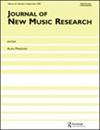Explaining harmonic inter-annotator disagreement using Hugo Riemann's theory of ‘harmonic function’
IF 0.9
4区 计算机科学
Q4 COMPUTER SCIENCE, INTERDISCIPLINARY APPLICATIONS
引用次数: 5
Abstract
ABSTRACT Harmonic transcriptions by ear rely heavily on subjective perceptions, which can lead to disagreement between annotators. The current computational metrics employed to measure annotator disagreement are useful for determining similarity on a pitch-class level, but are agnostic to the functional properties of chords. In contrast, music theories like Hugo Riemann's theory of ‘harmonic function’ acknowledge the similarity between chords currently unrecognised by computational metrics. This paper, utilises Riemann's theory to explain the harmonic annotator disagreements in the Chordify Annotator Subjectivity Dataset. This theory allows us to explain 82% of the dataset, compared to the 66% explained using pitch-class based methods alone. This new interdisiplinary application of Riemann's theory increases our understanding of harmonic disagreement and introduces a method for improving harmonic evaluation metrics that takes into account the function of a chord in relation to a tonal centre.用Hugo Riemann的“调和函数”理论解释调和注释者之间的分歧
摘要耳朵的谐波转录在很大程度上依赖于主观感知,这可能导致注释者之间的分歧。目前用于测量注释者分歧的计算指标有助于确定音高类水平上的相似性,但对和弦的功能特性是不可知的。相比之下,像雨果·里曼的“调和函数”理论这样的音乐理论承认了目前未被计算指标识别的和弦之间的相似性。本文利用黎曼理论解释了Chordify注释主体性数据集中调和注释主体的分歧。这一理论使我们能够解释82%的数据集,而单独使用基于音高类的方法解释的数据集为66%。黎曼理论的这一新的跨学科应用增加了我们对和声不一致的理解,并引入了一种改进和声评估指标的方法,该方法考虑了和弦相对于音调中心的功能。
本文章由计算机程序翻译,如有差异,请以英文原文为准。
求助全文
约1分钟内获得全文
求助全文
来源期刊

Journal of New Music Research
工程技术-计算机:跨学科应用
CiteScore
3.20
自引率
0.00%
发文量
5
审稿时长
>12 weeks
期刊介绍:
The Journal of New Music Research (JNMR) publishes material which increases our understanding of music and musical processes by systematic, scientific and technological means. Research published in the journal is innovative, empirically grounded and often, but not exclusively, uses quantitative methods. Articles are both musically relevant and scientifically rigorous, giving full technical details. No bounds are placed on the music or musical behaviours at issue: popular music, music of diverse cultures and the canon of western classical music are all within the Journal’s scope. Articles deal with theory, analysis, composition, performance, uses of music, instruments and other music technologies. The Journal was founded in 1972 with the original title Interface to reflect its interdisciplinary nature, drawing on musicology (including music theory), computer science, psychology, acoustics, philosophy, and other disciplines.
 求助内容:
求助内容: 应助结果提醒方式:
应助结果提醒方式:


